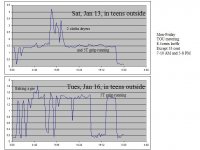jaggedben
Senior Member
- Location
- Northern California
- Occupation
- Solar and Energy Storage Installer
How often does the initial ramp of the temperature cycle actually require full current for more than 3 hours? I.e. the target rate of temperature rise, plus the heat loss rate, exceeds what the heater can puts out, so it stays at full current?
Cheers, Wayne
What I said was based on my recollection from having seen consumption data for a house with a kiln. The data for several hour intervals in the middle of the kiln cycle was roughly the nameplate kW of the kiln above the otherwise normal usage. I could be wrong but as you ask these questions and I try to recollect it again, I have the impression that the peak temperature would actually be the equilibrium of the heat loss at continuous full power. Which seems plausible given that as I look up kiln temps, they're several times the max temp of an electric kitchen oven for the same size circuit. Also it seems plausible they want the temperature to be a smooth curve, not go up and down with cycle on and off. The firing cycle is like 20hr or something.


